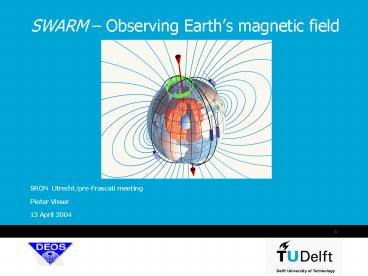SWARM Observing Earths magnetic field - PowerPoint PPT Presentation
1 / 12
Title:
SWARM Observing Earths magnetic field
Description:
Precise orbit determination was crucial for the. original secondary objective of atmospheric profiling, and ... composition, lithosphere modeling ( seismology) ... – PowerPoint PPT presentation
Number of Views:50
Avg rating:3.0/5.0
Title: SWARM Observing Earths magnetic field
1
SWARM Observing Earths magnetic field
SRON Utrecht/pre-Frascati meeting
Pieter Visser
2
DISCLAIMER
- Field of expertise is Orbital Mechanics, not
Magnetic Field - research. Precise orbit determination was crucial
for the - original secondary objective of atmospheric
profiling, and - still is for space-borne accelerometry, required
for studying - coupling between atmospheric density and magnetic
field. - P. Visser Member SWARM Mission Advisory Group
3
The mission
4
The Earths magnetic field
The objective of swarm is to separate the
various sources and processes that contribute to
the geomagnetic field at different time and
spatial scales.
5
(No Transcript)
6
Relevance to Earth Explorer Program research
objectives
Ref. SP-1227 Theme 1 Earth Interior (c)
Magnetic Field and Earth Interior Processes The
main magnetic field and its temporal variation is
the key source of data for studying core
processes, in particular the kinematics of the
flow of the bulk of the core and the exact nature
of the coupling mechanism between the core and
the mantle. Better global description of the
vector magnetic field and the subsequent
separation between core motion, secular
variation, jerks and low frequency variations in
the observed length-of-day, requires that the
components of the global magnetic field have to
be quantified to an accuracy of better than 1.5
nT.
7
The need for observations from space
- global homogeneous, high-precision and
high-resolution sampling - required within a short time span
- certain magnetic sources can only be observed by
space-borne - techniques (e.g. ionosphere, thermosphere)
- ground data will complement data and also offer
possibility for - validation of space-borne results
Timing and excellence
- a launch in 2008 makes Swarm an important
element in the - International Decade of Geopotential Research
program - a constellation of 3 satellites allows unique
high-resolution sampling - and decoupling of magnetic field sources in
space and time
8
Scientific relevance
- understanding magnetic field weakening (8 of
dominant dipole over - the last 150 years, 10 for South-Atlantic
Anomaly over the last 20 years) - ? are we close to a reversal?
- better mapping of time-variable geomagnetic
field required for - understanding of e.g. fluid core dynamics
- higher resolution models required for
lithosphere for better understanding - of history of the global field and geological
activity - construction for the 1st time of global 3-D
images of mantle electrical - conductivity ? insight in mantle chemical
composition and temperature - and this mantle dynamics
- magnetic field is of primary importance for the
external environment - of the Earth, providing information about the
coupled Sun-Earth system
9
Societal relevance
- User community readiness
- International Association of Geomagnetism and
Aeronomy (IAGA, part of IUGG) - - IAGA provides the International Geomagnetic
Field Reference (IGRF) - product, widely used also outside the
geomagnetic community - (applications ranging from navigation to field
line tracing for external - field studies).
- Continuation of International Decade of
Geoptential Research that started in - 1999 with Ørsted followed by CHAMP and SAC-C
(all single-satellite missions). - As an example more than 50 groups from 14
different countries make use of and - analyze Ørsted observations.
- Long-term programs
- - Danish Space Research Institute
- - Deutsches Forschungs Gemeinschaft
- - Center National de la Reserche Scientifique en
CNES - - Geospace (British Geological Survey and
several universities) - - US programs US national research council and
Solid Earth Science - Working Group (need for observations covering
at least two solar - cycles or 22 years!)
10
Application potential
11
Other issues
- - Cooperation with other space agencies
- NASA (USA)
- Mission Advisory Group member from GSFC
- Radio antennae for atmospheric profiling
(currently not in - baseline, but can be accommodated)
- ESA Space Science Directorate - CSA (Canada)
- Possibility for EFI contribution (spin off to
space - science program)
- Synergy with gravity (GRACE, GOCE)
- the gravity and magnetic fields are the only two
remotely sensed - fields that can provide constraints on the
Earths deep interior - in a manner very different from natural seismic
analysis
12
Role of the Netherlands
- Industry
- NLR contributed to Phase A study focusing on
Attitude and - Orbit Control System
- - Fokker possible provider of solar panels
- Science
- collaboration between Faculty of Earth Sciences,
Utrecht University, - and School of Earth Sciences, Leeds University
deep mantle - composition, lithosphere modeling (
seismology) - DEOS, Delft University of Technology
accelerometer calibration, - precise orbit determination
- Other???































